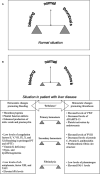The concept of rebalanced hemostasis in patients with liver disease: Communication from the ISTH SSC working group on hemostatic management of patients with liver disease
- PMID: 33792172
- PMCID: PMC8252070
- DOI: 10.1111/jth.15239
The concept of rebalanced hemostasis in patients with liver disease: Communication from the ISTH SSC working group on hemostatic management of patients with liver disease
Abstract
Patients with liver diseases acquire complex alterations in their hemostatic system that may lead to abnormalities in routine diagnostic test of hemostasis. Thrombocytopenia, prolongations in the prothrombin time and activated partial thromboplastin time, and decreased plasma fibrinogen are common in patients with advanced liver disease. Historically, liver diseases therefore have been classified as an acquired bleeding disorder. Laboratory and clinical observations have demonstrated that although routine diagnostic tests of hemostasis suggest a hypocoagulable state, patients with liver disease also tend to develop thrombotic events. Overall, patients have commensurate changes in both pro- and antihemostatic pathways. This new hemostatic balance, however, appears much more fragile than the hemostatic balance in individuals with normal liver function, and patients with liver disease can readily experience both hemostasis-related bleeding and thrombotic events. These insights into the hemostatic balance in patients with liver disease have led to revised recommendations for clinical management of hemostasis. In 2020, an SSC working group within the ISTH has been founded with the aim to disseminate new concepts on prevention and treatment of bleeding and thrombosis in patients with liver disease. The current document will outline the hemostatic changes in patients with liver disease, the limitations of routine diagnostic tests of hemostasis, and the concept of rebalanced hemostasis.
Keywords: bleeding; cirrhosis; liver diseases; thrombosis.
© 2021 The Authors. Journal of Thrombosis and Haemostasis published by Wiley Periodicals LLC on behalf of International Society on Thrombosis and Haemostasis.
Conflict of interest statement
We have no conflicts of interest to report.
Figures

References
-
- Tripodi A, Mannucci PM. The coagulopathy of chronic liver disease. N Engl J Med. 2011;365:147‐156. - PubMed
-
- Lisman T, Porte RJ. Rebalanced hemostasis in patients with liver disease: evidence and clinical consequences. Blood. 2010;116:878‐885. - PubMed
-
- Ambrosino P, Tarantino L, Di Minno G, et al. The risk of venous thromboembolism in patients with cirrhosis: a systematic review and meta‐analysis. Thromb Haemost. 2017;117:139‐148. - PubMed
-
- Qi X, Ren W, Guo X, Fan D. Epidemiology of venous thromboembolism in patients with liver diseases: a systematic review and meta‐analysis. Intern Emerg Med. 2015;10:205‐217. - PubMed
MeSH terms
Substances
LinkOut - more resources
Full Text Sources
Other Literature Sources
Medical

